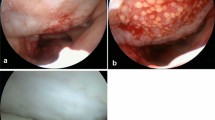Abstract
Full size retropatellar cartilage lesions are troublesome conditions to treat and an autologous chondrocyte implantation with or without matrix or scaffold in supine position is difficult. Usually, it is necessary to perform a large arthrotomy to evert the patella in order to get sufficient access to the retropatellar cartilage defect. The procedure is associated with a significant parapatellar soft tissue trauma to the patient. This technical note introcudes a minimal invasive approach with the patient in prone position using an all-arthroscopic or mini-open technique to treat retropatellar full size articular cartilage lesions of the patella.





Similar content being viewed by others
References
Anderer U, Libera J (2002) In vitro engineering of human autogenous cartilage. J Bone Miner Res 17:1420–1429
Andereya S, Maus U, Gavenis K, Gravius S, Stanzel S, Müller-Rath R, Miltner O, Mumme T, Schneider U (2007) Treatment of patellofemoral cartilage defects utilizing a 3D collagen gel: two-year clinical results. Z Orthop Unfall 145:139–145
Basad E, Ishaque B, Bachmann G, Stürz H, Steinmeyer J (2010) Matrix-induced autologous chondrocyte implantation versus microfracture in the treatment of cartilage defects of the knee: a 2-year randomised study. Knee Surg Sports Traumatol Arthrosc 18:519–527
Behrens P, Bitter T, Kurz B, Russlies M (2006) Matrix-associated autologous chondrocyte transplantation/implantation (MACT/MACI)–5-year follow-up. Knee 13:194–202
Benthien JP, Behrens P (2010) Autologous matrix-induced chondrogenesis (AMIC). A one-step procedure for retropatellar articular resurfacing. Acta Orthop Belg 76:260–263
Benthien JP, Behrens P (2011) The treatment of chondral and osteochondral defects of the knee with autologous matrix-induced chondrogenesis (AMIC): method description and recent developments. Knee Surg Sports Traumatol Arthrosc PMID: 21234543. [Epub ahead of print]
Brittberg M (2010) Cell carriers as the next generation of cell therapy for cartilage repair: a review of the matrix-induced autologous chondrocyte implantation procedure. Am J Sports Med 38:1259–1271
Dhollander AA, De Neve F, Almqvist KF, Verdonk R, Lambrecht S, Elewaut D, Verbruggen G, Verdonk PC (2011) Autologous matrix-induced chondrogenesis combined with platelet-rich plasma gel: technical description and a five pilot patients report. Knee Surg Sports Traumatol Arthrosc 19:536–542
Haddo O, Mahroof S, Higgs D, David L, Pringle J, Bayliss M, Cannon SR, Briggs TW (2004) The use of chondrogide membrane in autologous chondrocyte implantation. Knee 11:51–55
Horas U, Pelinkovic D, Herr G, Aigner T, Schnettler R (2003) Autologous chondrocyte implantation and osteochondral cylinder transplantation in cartilage repair of the knee joint: a prospective, comparative trial. J Bone Joint Surg Am 85:185–192
Hunziker E, Spector M, Libera J, Gertzman A, Woo SL, Ratcliffe A, Lysaght M, Coury A, Kaplan D, Vunjak-Novakovic G (2006) Translation from research to applications. Tissue Eng 12:3341–3364
Litzke LE, Wagner E, Baumgaertner W, Hetzel U, Josimović-Alasević O, Libera J (2004) Repair of extensive articular cartilage defects in horses by autologous chondrocyte transplantation. Ann Biomed Eng 32:57–69
McNickle AG, Provencher MT, Cole BJ (2008) Overview of existing cartilage repair technology. Sports Med Arthrosc 16:196–201
Minas T (2001) Autologous chondrocyte implantation for focal chondral defects of the knee. Clin Orthop Relat Res 391:349–361
Nehrer S, Dorotka R, Domayer S, Stelzeneder D, Kotz R (2009) Treatment of full-thickness chondral defects with hyalograft C in the knee: a prospective clinical case series with 2 to 7 years follow-up. Am J Sports Med 37(Suppl 1):81–87
Niemeyer P, Kreuz PC, Steinwachs M, Köstler W, Mehlhorn A, Kraft N, Südkamp NP (2007) Technical note: the “double eye” technique as a modification of autologous chondrocyte implantation for the treatment of retropatellar cartilage defects. Knee Surg Sports Traumatol Arthrosc 15:1461–1468
Niemeyer P, Pestka JM, Kreuz PC, Erggelet C, Schmal H, Suedkamp NP, Steinwachs M (2008) Characteristic complications after autologous chondrocyte implantation for cartilage defects of the knee joint. Am J Sports Med 36:2091–2099
Ossendorf C, Kaps C, Kreuz PC, Burmester GR, Sittinger M, Erggelet C (2007) Treatment of posttraumatic and focal osteoarthritic cartilage defects of the knee with autologous polymer-based three- dimensional chondrocyte grafts: 2-year clinical results. Arthritis Res Ther 9:41
Pascual-Garrido C, Slabaugh MA, L’Heureux DR, Friel NA, Cole BJ (2009) Recommendations and treatment outcomes for patellofemoral articular cartilage defects with autologous chondrocyte implantation: prospective evaluation at average 4-year follow-up. Am J Sports Med 37:33–41
Rössing S, Thermann H, Paessler H, Baum P, Schreyer T (2007) For discussion–new technique for arthroscopic, autologous chondrocyte transplantation using chondrospheres. Z Orthop Unfall 145:276–277
Schubert T, Anders S, Neumann E, Schölmerich J, Hofstädter F, Grifka J, Müller-Ladner U, Libera J, Schedel J (2009) Long-term effects of chondrospheres on cartilage lesions in an autologous chondrocyte implantation model as investigated in the SCID mouse model. Int J Mol Med 23:455–460
Steinwachs M (2009) New technique for cell-seeded collagen-matrix-supported autologous chondrocyte transplantation. Arthroscopy 25:208–211
Thermann H, Driessen A, Becher C (2008) Autologous chondrocyte transplantation in the treatment of articular cartilage lesions of the talus. Orthopade 37:232–239
Vasiliadis HS, Wasiak J (2010) Autologous chondrocyte implantation for full thickness articular cartilage defects of the knee. Cochrane Database Syst Rev 6:CD003323
Zeifang F, Oberle D, Nierhoff C, Richter W, Moradi B, Schmitt H (2010) Autologous chondrocyte implantation using the original periosteum-cover technique versus matrix-associated autologous chondrocyte implantation: a randomized clinical trial. Am J Sports Med 38:924–933
Author information
Authors and Affiliations
Corresponding author
Rights and permissions
About this article
Cite this article
Siebold, R., Sartory, N., Yang, Y. et al. Prone position for minimal invasive or all-arthroscopic autologous chondrocyte implantation at the patella. Knee Surg Sports Traumatol Arthrosc 19, 2036–2039 (2011). https://doi.org/10.1007/s00167-011-1505-1
Received:
Accepted:
Published:
Issue Date:
DOI: https://doi.org/10.1007/s00167-011-1505-1




